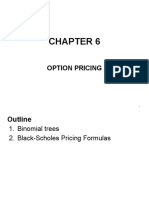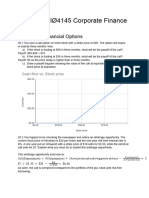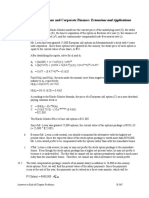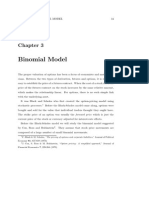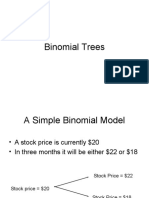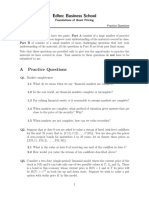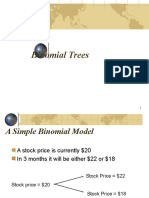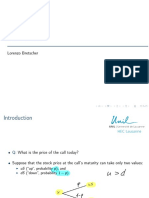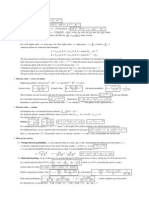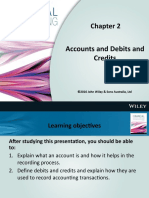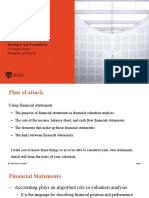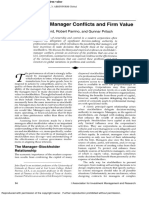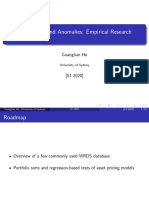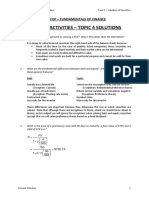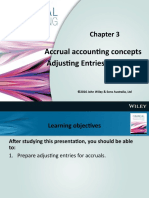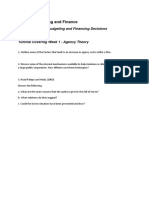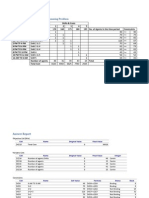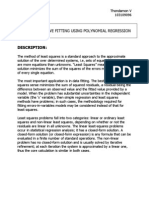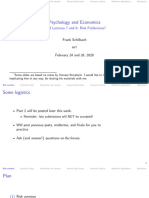Week 4 Tutorial Questions and Solutions
21-1. The current price of Estelle Corporation stock is $25. In each of the next two years, this stock price
will either go up by 20% or go down by 20%. The stock pays no dividends. The one-year risk-free
interest rate is 6% and will remain constant. Using the Binomial Model, calculate the price of a
one-year call option on Estelle stock with a strike price of $25.
In this case, the stock price either rises to Su = 25 × 1.20 = 30 or falls to Sd = 25 × 0.80 = 20. The option
payoff is therefore either Cu = 5 or Cd = 0. The replicating portfolio is = (5 − 0)(30 − 20) = 0.5 and
B = (0 − 20 × 0.5)1.06 = −9.43.
Therefore, C = 0.5 × 25 − 9.43 = $3.07.
21-2. Using the information in Problem 1, use the Binomial Model to calculate the price of a one year
put option on Estelle stock with a strike price of $25.
The parameters are the same as in 21-1, but the payoff of the put is 0 if the stock goes up and 5 if the
stock goes down. Therefore, the replicating portfolio is
= (0 − 5)(30 − 20) = –0.5 and B = (5 − 20×(–0.5))1.06 = .
Therefore, P = –0.5 × 25 + = $1.65.
21-3. The current price of Natasha Corporation stock is $6. In each of the next two years, this stock price
can either go up by $2.50 or go down by $2. The stock pays no dividends. The one-year risk-free
interest rate is 3% and will remain constant. Using the Binomial Model, calculate the price of a
two-year call option on Natasha stock with a strike price of $7.
Up state at time 1: = (4 − 0)(11 − 6.50) = 0.889, B = (0 − 6.50×0.889)1.03 = −5.61, therefore Cu =
0.889 × 8.50 − 5.61 = $1.95.
In the down state at time 1 the option is worth nothing. The call option at time 0 is therefore equivalent
to the replicating portfolio = (1.95 − 0)(8.50 − 4) = 0.433, B = (0 − 4 × 0.433)1.03 = −1.68 and so, by
the Law of One Price, the initial option price is 0.433 × 6 − 1.68 = $0.92.
21-4. Using the information in Problem 3, use the Binomial Model to calculate the price of a two-year
European put option on Natasha stock with a strike price of $7.
If the stock goes up twice, the put is worth zero. If the stock ends up at $6.50, the put is worth $0.50; if
the stock goes down twice, the put is worth $5. Given these final values, we can calculate the value of
the put at earlier dates using the binomial model.
Up state at time 1: = (0 − 50)(11 – 6.50) = –0.111 and B = (0.50 − × (–0.111))1.03 = .
� Therefore, Pu = –0.111 × 8.50 + = $0.25.
Down state at time 1: = (0.50 − )(6.50 – 2) = –1 and B = (5 − ×(–1))1.03 =
Therefore, Pd = –1 × 4 + = $2.80.
Time 0: = (0.25 − )(8.50 – 4) = –0.567 and B = (2.80 − × (–0.567))1.03 =
Therefore, Pd = –0.567 × 6 + = $1.52.
21-7. Eagletron’s current stock price is $10. Suppose that over the current year, the stock price will
either increase by 100% or decrease by 50%. Also, the risk-free rate is 25% (EAR).
a. What is the value today of a one-year at-the-money European put option on Eagletron stock?
b. What is the value today of a one-year European put option on Eagletron stock with a strike
price of $20?
c. Suppose the put options in parts a and b could either be exercised immediately, or in one year.
What would their values be in this case?
a. Pu = 0, Pd = 5, delta = (0 – 5)/(20 – 5) = –1/3, B = (5 – 5(–1/3))/1.25 = 5.33
P = –1/3(10) + 5.33 = $2.00
b. The payoffs are Pu = 0, Pd = 15. Because these payoffs are three times the payoffs in (a), the put
must be worth 3 $2 = $6.
c. We can exercise the put immediately and get its intrinsic value. In (a), intrinsic value = 0, so not
relevant, value is still $2
In (b) intrinsic value = 20 – 10 = $10, so it is better to exercise now → value is $10 (not $6).
21-12. Rebecca is interested in purchasing a European call on a hot new stock, Up, Inc. The call has a
strike price of $100 and expires in 90 days. The current price of Up stock is $120, and the stock has
a standard deviation of 40% per year. The risk-free interest rate is 6.18% per year.
a. Using the Black-Scholes formula, compute the price of the call.
b. Use put-call parity to compute the price of the put with the same strike and expiration date.
a. Using the Black-Sholes formula:
120
90 ln
= 98.487, d1 =
98.487 0.4 90 / 365
PV(K) = 100 / (1.0638) 365
+ = 1.094
0.4 90 / 365 2
= 1.09167
d2 = 1.094 − 0.4 90 / 365 = 0.895
C = S N ( d1 ) − PV ( K ) N ( d2 ) = 120 0.863 − 98.487 0.815 = $23.29
b. Using put-call parity:
P = C + PV ( K ) − S = 23.29 + 98.487 − 120 = $1.78
21-19. Harbin Manufacturing has 10 million shares outstanding with a current share price of $20 per
share. In one year, the share price is equally likely to be $30 or $18. The risk-free interest rate is
5%.
a. What is the expected return on Harbin stock?
b. What is the risk neutral probability that Harbin’s stock price will increase?
� a. 0.5(30+18)/20 – 1 = 20%
b. 25%
21-20. Using the information on Harbin Manufacturing in Problem 19, answer the following:
a. Using the risk neutral probabilities, what is the value of a one-year call option on Harbin stock
with a strike price of $25?
b. What is the expected return of the call option?
c. Using the risk neutral probabilities, what is the value of a one-year put option on Harbin stock
with a strike price of $25?
d. What is the expected return of the put option?
a. 25% (30 – 25)/1.05 = $1.19
b. 50% (5)/1.19 – 1 = 110%
c. 75% (25 – 18)/1.05 = $5
d. 50% (7)/5 – 1 = –30%
21-21. Using the information in Problem 1, calculate the risk-neutral probabilities. Then use them to price
the option.
The risk neutral probabilities can be calculated using:
(1 + rf ) S − Sd (1.06)25 − 20
= = = 0.65.
Su − Sd 30 − 20
Using these probabilities the price of the option is
5 ( 0.65) + 0 ( 0.35)
= $3.066.
1.06
21-22. Using the information in Problem 3, calculate the risk-neutral probabilities. Then use them to price
the option.
The risk neutral probabilities are
(1.03)6 − 4
p1 = = 48.44%
8.5 − 4
(1.03)8.5 − 6.5
p2u = = 50.11%
11 − 6.5
(1.03)4 − 2
p2d = = 47.11%.
6.5 − 2
The value of the call is therefore:
(4 p p + 0 ( p1 (1 − p2u ) + (1 − p1 )( p2 d ) ) + 0 (1 − p1 )(1 − p2 d ) )
1
2 1 2u
1.03
4 ( 0.4844 )( 0.5011)
= 2
= $0.9153
1.03
21-23. Explain the difference between the risk-neutral and actual probabilities. In which states is one
higher than the other? Why?
� Actual probabilities are the probabilities with which an event will happen. Risk-neutral probabilities are
the probabilities of an event happening in a world where investors are risk-neutral. Thus, risk-neutral
probabilities are a construction and do not reflect reality. Assuming that investors are risk-averse, risk-
neutral probabilities are lower in good states and larger in bad states. This has to be the case because if
investors were risk-neutral, then the expected returns are the risk-free rate, whereas risk-averse demand
higher returns. And given the same payoffs, a higher expected return implies good states are more likely.
21-24. Explain why risk-neutral probabilities can be used to price derivative securities in a world where
investors are risk averse.
Risk neutral probabilities can be used to price derivative securities because the pricing of derivatives
only depends on the characteristics of the underlying asset. By construction, the value of the underlying
asset can be calculated using risk-neutral probabilities and therefore the value of the call will depend on
these probabilities. Risk-neutral probabilities are the easiest probabilities to work with, given that they
simplify the calculations, and that is why we use them.
21-28. You would like to know the unlevered beta of Schwartz Industries (SI). SI’s value of outstanding
equity is $400 million, and you have estimated its beta to be 1.2. SI has four-year zero-coupon debt
outstanding with a face value of $100 million that currently trades for $75 million. SI pays no
dividends and reinvests all of its earnings. The four-year risk-free rate of interest is currently
5.13%. Use the Black-Scholes formula to estimate the unlevered beta of the firm.
The equity can be interpreted as a four-year call option on the firm's assets with a strike price of $100
million. The current market value of assets is 400 + 75 = $475 million.
Using the Black-Scholes formula, we can get the implied volatility of assets: Call option value = 400, K
= 100, S = 475, T = 4, r = 0.0513 = 60.6%.
Using the volatility:
475
ln
+ 0.0513) 4
= N (d1 ) = N + 0.606 4 = 0.980
100 / (1
0.606 4 2
1.2
= E = = 1.03
U D 75
1 + 0.980 1 +
E 400
a. D = 900/1.095 = 585. S = D + E = 585 + 20 25 = 1085, rf = 5%, K = 900, T = 5
Vol = 35%
b. B_d D/B_e E = (1 – delta)/delta = (1 – 0.827)/0.827 = 0.209
c. Asset value could fall to 1008, and with volatility of 45%, equity call option is worth 500. Thus,
NPV could be 1,008 – 1,085 = –77 million, and equity holders still gain!
